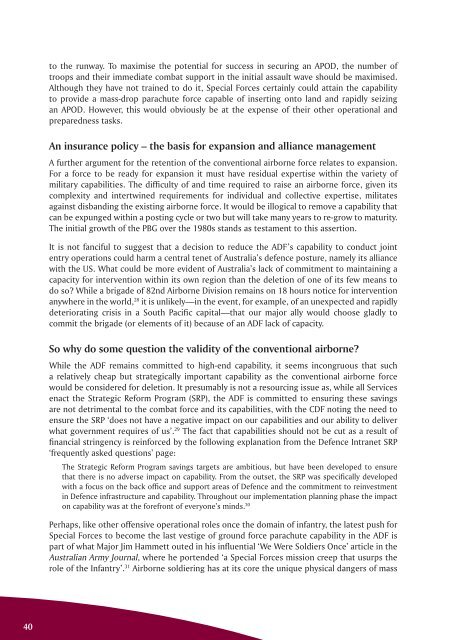ISSUE 183 : Nov/Dec - 2010 - Australian Defence Force Journal
ISSUE 183 : Nov/Dec - 2010 - Australian Defence Force Journal
ISSUE 183 : Nov/Dec - 2010 - Australian Defence Force Journal
Create successful ePaper yourself
Turn your PDF publications into a flip-book with our unique Google optimized e-Paper software.
to the runway. To maximise the potential for success in securing an APOD, the number oftroops and their immediate combat support in the initial assault wave should be maximised.Although they have not trained to do it, Special <strong>Force</strong>s certainly could attain the capabilityto provide a mass-drop parachute force capable of inserting onto land and rapidly seizingan APOD. However, this would obviously be at the expense of their other operational andpreparedness tasks.An insurance policy – the basis for expansion and alliance managementA further argument for the retention of the conventional airborne force relates to expansion.For a force to be ready for expansion it must have residual expertise within the variety ofmilitary capabilities. The difficulty of and time required to raise an airborne force, given itscomplexity and intertwined requirements for individual and collective expertise, militatesagainst disbanding the existing airborne force. It would be illogical to remove a capability thatcan be expunged within a posting cycle or two but will take many years to re-grow to maturity.The initial growth of the PBG over the 1980s stands as testament to this assertion.It is not fanciful to suggest that a decision to reduce the ADF’s capability to conduct jointentry operations could harm a central tenet of Australia’s defence posture, namely its alliancewith the US. What could be more evident of Australia’s lack of commitment to maintaining acapacity for intervention within its own region than the deletion of one of its few means todo so? While a brigade of 82nd Airborne Division remains on 18 hours notice for interventionanywhere in the world, 28 it is unlikely—in the event, for example, of an unexpected and rapidlydeteriorating crisis in a South Pacific capital—that our major ally would choose gladly tocommit the brigade (or elements of it) because of an ADF lack of capacity.So why do some question the validity of the conventional airborne?While the ADF remains committed to high-end capability, it seems incongruous that sucha relatively cheap but strategically important capability as the conventional airborne forcewould be considered for deletion. It presumably is not a resourcing issue as, while all Servicesenact the Strategic Reform Program (SRP), the ADF is committed to ensuring these savingsare not detrimental to the combat force and its capabilities, with the CDF noting the need toensure the SRP ‘does not have a negative impact on our capabilities and our ability to deliverwhat government requires of us’. 29 The fact that capabilities should not be cut as a result offinancial stringency is reinforced by the following explanation from the <strong>Defence</strong> Intranet SRP‘frequently asked questions’ page:The Strategic Reform Program savings targets are ambitious, but have been developed to ensurethat there is no adverse impact on capability. From the outset, the SRP was specifically developedwith a focus on the back office and support areas of <strong>Defence</strong> and the commitment to reinvestmentin <strong>Defence</strong> infrastructure and capability. Throughout our implementation planning phase the impacton capability was at the forefront of everyone’s minds. 30Perhaps, like other offensive operational roles once the domain of infantry, the latest push forSpecial <strong>Force</strong>s to become the last vestige of ground force parachute capability in the ADF ispart of what Major Jim Hammett outed in his influential ‘We Were Soldiers Once’ article in the<strong>Australian</strong> Army <strong>Journal</strong>, where he portended ‘a Special <strong>Force</strong>s mission creep that usurps therole of the Infantry’. 31 Airborne soldiering has at its core the unique physical dangers of mass40
















